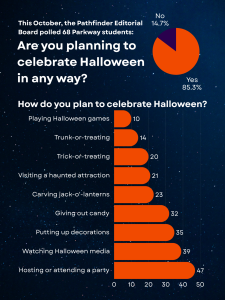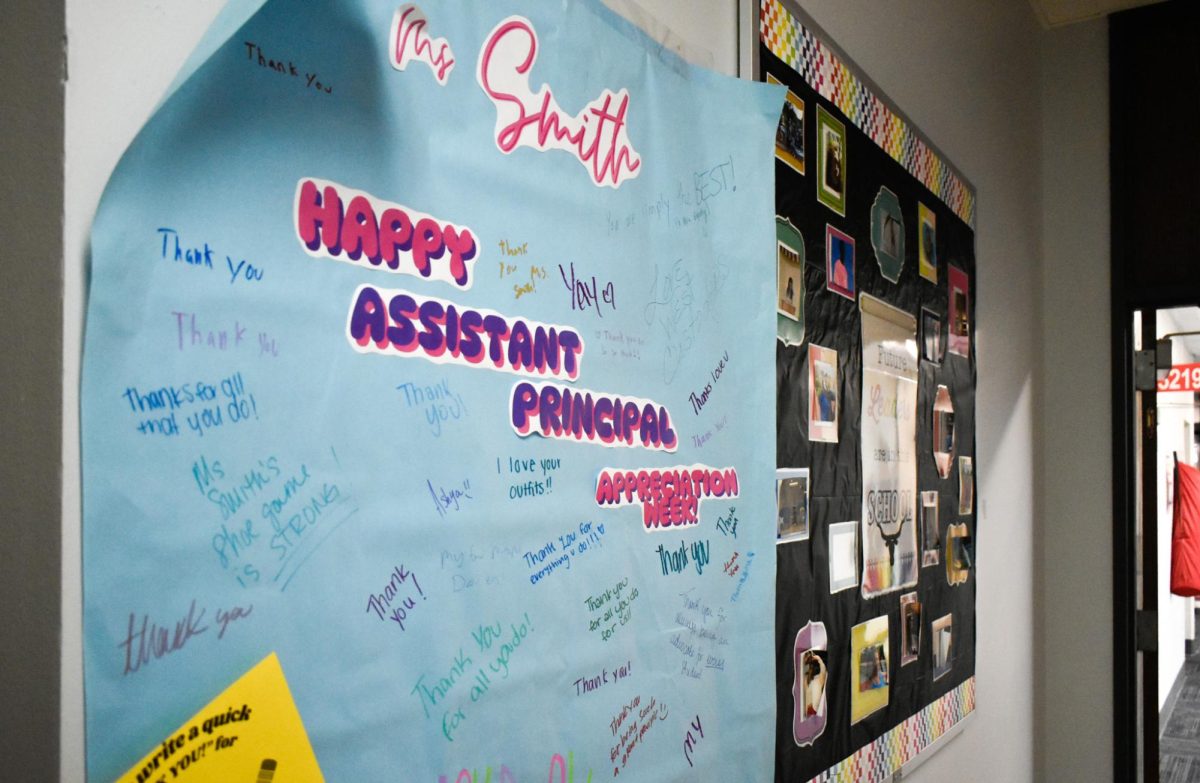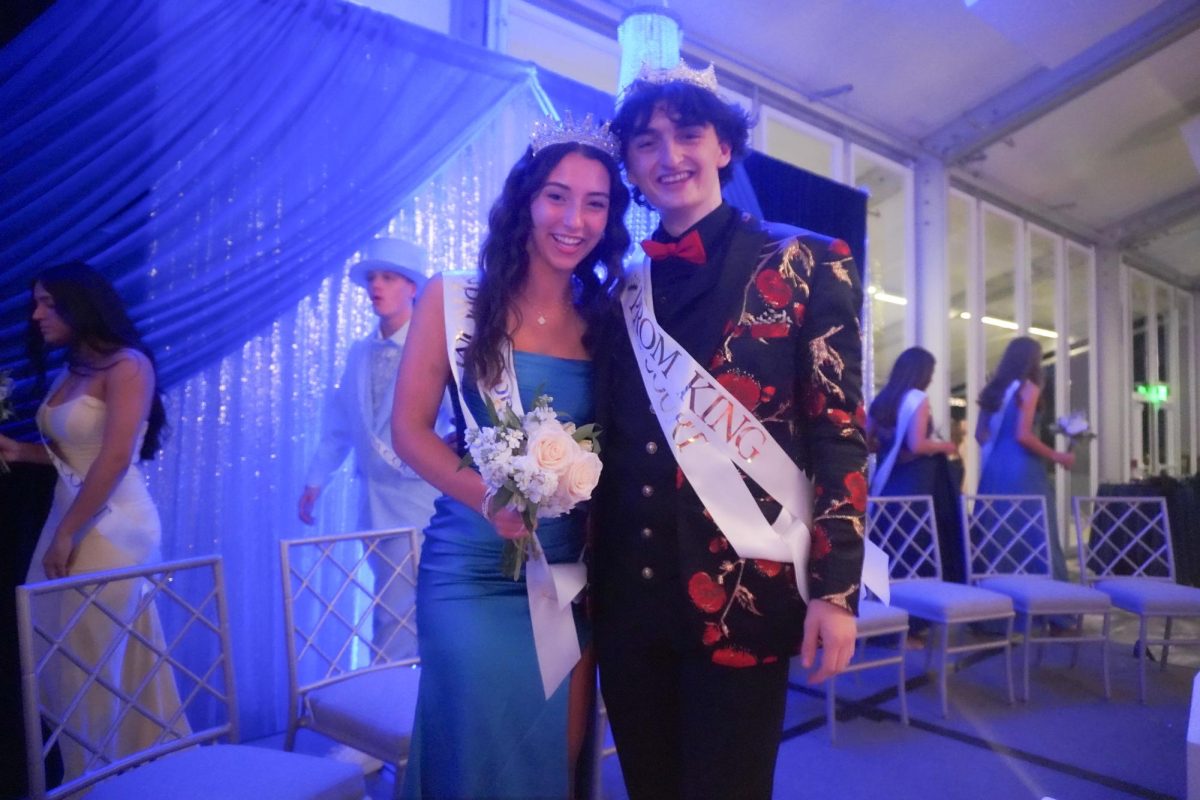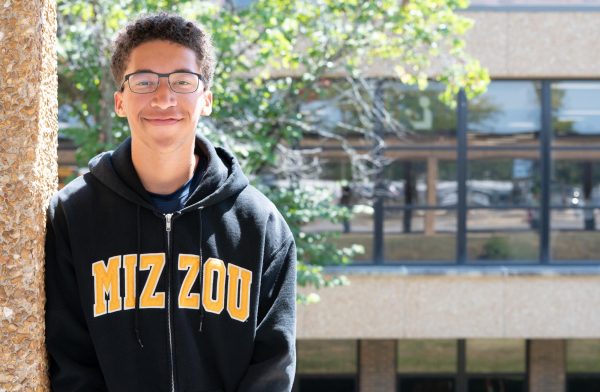Buckets filled with candy and fake blood dripping from costumes, excited trick-or-treaters knock on every neighborhood door. A holiday for people of all ages, Halloween has trademark traditions, such as pumpkin carving, haunted houses and, most famously, trick-or-treating. For many, memories of dusky fall nights spent collecting candy until fingers turn numb are central to the very idea of Halloween, yet, in recent years, many have noticed an absence of this classic festivity.┬Ā
At West High, students are feeling a similar sense of apathy towards traditional Halloween celebrations, seemingly moving toward mature observances of the holiday. In fact, a recent poll of 68 Parkway students, conducted by the Pathfinder Editorial Board, revealed that 50% of respondents have noticed fewer Halloween celebrations than in past years. This decline suggests that Halloween traditions are shifting from community-based to more individual experiences. As the nostalgic celebrations of the holiday are becoming less common, especially for West High Students, weŌĆÖre simply witnessing a turning point in history õĖĆ a change that we have the chance to embrace.
┬ĀEnglish teacher Daniel Barnes has been an observer of Halloween and often celebrates with his children. Barnes, however, noticed that fewer houses were participating in holiday celebrations.┬Ā
ŌĆ£When I took my kids out last year, there were a lot of porch lights turned off,ŌĆØ Barnes said.┬Ā
This transformation of the holiday may be due to an up-and-coming tradition known as trunk or treat. West High held its own trunk or treat celebration on Oct. 30, inviting children of all ages to participate.┬Ā
Trunk or treat was first hosted in 1994, when a Birmingham church was looking for a safer way for concerned parents to celebrate Halloween. Their convenience and security made them popular among parents, who embraced them as a supplement or even replacement for trick-or-treating. 30 years later, a survey by Nextdoor found that 72% of parents planned to attend or host a trunk or treat.┬Ā
ŌĆ£I believe trunk or treats are taking over [the practice of] trick-or-treating. ItŌĆÖs easier to have your [children] go to one location, get the candy and then come home, as opposed to having to trek all around a neighborhood,ŌĆØ Barnes said.
Unlike door-to-door trick-or-treating, trunk-or-treating is concentrated and supervised, so guardians can keep a watchful eye on their children. School Resource Officer Matthew Paubel suggests itŌĆÖs not only rumors of razor blades in candy and Halloween thrillers that contribute to parentsŌĆÖ new inclination to avoid the neighborhood route, but itŌĆÖs also a loss of trust in neighbors. According to the Pew Research Center, 52% of Americans in 2015 said they trusted most or all their neighbors; by 2025, that number fell to 44%. While the statistic may not seem staggering, itŌĆÖs a concerning discrepancy for only a decade. For parents who do allow their children to trick-or-treat, trust plays a vital role in that decision.
ŌĆ£[Trunk-or-treating] makes people feel more safe, because [everyone is] in one area,ŌĆØ Paubel said. ŌĆ£People know everythingŌĆÖs going to be safe and controlled. With a neighborhood, you [could have] that weird house down the street.ŌĆØ
This loss of trust can be attributed to what individuals see on social media; isolated incidents may appear on individual social media feeds. The rise of easily accessible digital media, not soaring crime rates, has contributed to the shift in public perception. On social media, things can seem more dangerous than they truly are.
ŌĆ£I donŌĆÖt know that [there are any more] incidents than 50 years ago. ItŌĆÖs just that people are more aware of them. Because of social media [and] cell phones, everyone can get information [about dangerous events] out a lot more quickly and even [falsely]. Perception has changed,ŌĆØ Paubel said.
In fact, Paubel explains that fears of trick-or-treating incidents have caused many to seek preemptive protection from law enforcement on Halloween night.
ŌĆ£Halloween for [law enforcement]┬Ā is [what] they call a blackout day: officers are not allowed to take that night off because we have so many requests [to attend] community events. People want to know that weŌĆÖre around [since] it gives them a sense of security. [Halloween is] just one of those days where anything can happen. [We should] be prepared for the worst [and] hope for the best,ŌĆØ Paubel said.
To some parents, the way to best safeguard their children is to avoid the risks of trick-or-treating overall. However, even if trick-or-treating declines, we must also recognize how our perception evolves with age. As children, everything from our physical size to the way we visualize the world around us is distinct; unique colors, shapes and a near-overload of new interactions transform trick-or-treating into an exhilarating experience. By contrast, the teenage brain is more risk-reward driven, so the novelty of attending a party often replaces a familiar walk around the neighborhood. Thus, while safety concerns and school events play a role, the biggest change likely lies in an evolving sense of what we find exciting about Halloween, and thus, how we plan to celebrate.

More than 85% of students still plan to observe Halloween. 81% of respondents will do so by hosting or attending a party. As individuals grow older, the traditions they once loved might no longer be as prevalent in their lives. Complied with safety concerns and media perceptions, these changes may even begin early on in oneŌĆÖs life. However, as upsetting as it may seem, for society to be shifting away from old traditions, it may actually be a symbol of progress.┬Ā
In a way, this transformation of Halloween and the phenomenon of growing up reflects an ability to be more cautious, inclusive and creative. Especially for those seeking a sensory stimulus, trunk or treat events provide a versatile experience.┬Ā As teenagers, cultural change is often foreign and alarming, and can feel like a loss. But itŌĆÖs not the end of tradition; itŌĆÖs their morphing into new ones. The spirit of Halloween survives because it adapts, both culture and our age.

![Dressed up as the varsity girlsŌĆÖ tennis coach Katelyn Arenos, senior Kate Johnson and junior Mireya David hand out candy at West HighŌĆÖs annual trunk or treat event. This year, the trunk or treat was moved inside as a result of adverse weather. ŌĆ£As a senior, I care less about Halloween now. Teachers will bring their kids and families [to WestŌĆÖs Trunk or Treat], but there were fewer [this year] because they just thought it was canceled [due to the] rain. [With] Halloween, I think you care less the older you get,ŌĆØ Johnson said.](https://pwestpathfinder.com/wp-content/uploads/2025/10/DSC00892-1-1200x800.jpg)

![Leaning on the podium, superintendent Melissa Schneider speaks to Parkway journalism students during a press conference. Schneider joined Parkway in July after working in the Thompson School District in Colorado. ŌĆ£My plan [to bond with students] is to get things on my calendar as much as possible. For example, being in [classes] is very special to me. I am trying to be opportunistic [meeting] kids [and] being in [the school] buildings. I have all the sports schedules and the fine arts schedules on my calendar, so that when I'm available, I can get to them,ŌĆØ Schneider said.](https://pwestpathfinder.com/wp-content/uploads/2025/09/IMG_5425-1200x943.jpeg)


![Red, white and blue, the American flag holds the values of our democracy. The fight that we once endured has returned, as student journalists and senior correspondents across the country are losing their voices due to government control. ŌĆ£[Are] the White House and [the] government limiting free speech [and] freedom of the press? Yes [they are],ŌĆØ chief communications officer of the Parkway School District and former journalist Elisa Tomich said.](https://pwestpathfinder.com/wp-content/uploads/2025/03/Untitled-design-14.jpg)
![A board in the Parkway West counseling department displays pennants of selective universities. With a wide range of students interested in attending, itŌĆÖs important that these schools have clear priorities when deciding who to admit. ŌĆ£[Washington University] had the major that I wanted, psychology, philosophy, neuroscience. That's a holistic study of the brain, and [WashU is] the only college in the world that offers that. That's the main reason I wanted to go; I got into that program,ŌĆØ senior Dima Layth said.](https://pwestpathfinder.com/wp-content/uploads/2025/02/Flag-1.png)

![Within the U.S., the busiest shopping period of the year is Cyber Week, the time from Thanksgiving through Black Friday and Cyber Monday. This year, shoppers spent $13.3 billion on Cyber Monday, which is a 7.3% year-over-year increase from 2023. ŌĆ£When I was younger, I would always be out with my mom getting Christmas gifts or just shopping in general. Now, as she has gotten older, I've noticed [that almost] every day, I'll open the front door and there's three packages that my mom has ordered. Part of that is she just doesn't always have the time to go to a store for 30 minutes to an hour, but the other part is when she gets bored, she has easy access to [shopping],ŌĆØ junior Grace Garetson said.](https://pwestpathfinder.com/wp-content/uploads/2024/12/DSC_0249.JPG-1200x801.jpg)

![Senior Sally Peters stands in the history hallway, contemplating her choices in the 2024 United States and Missouri elections on Nov. 5. As a member of Diplomacy Club, Peters has discussed key candidates and issues in contemporary American politics. ŌĆ£[As students], we're starting to become adults. We're realizing how much the policies that are enforced and the laws that make it through the House and Senate are starting to affect us. [Opportunities such as] AP [U.S.Government] and Diplomacy Club [make elections feel] a lot more real,ŌĆØ Diplomacy Club vice president and senior Nidhisha Pejathaya said.](https://pwestpathfinder.com/wp-content/uploads/2024/10/Flag-1-1.png)
![Mounting school pressure can leave many students overworked and overstressed. Schools must give students the necessary resources to help assuage student mental health issues and prevent the development of serious crises. ŌĆ£The biggest thing [schools] can do [to protect student mental health] is offer more time [to do work], like a study hall, or offer more support from teachers so that students don't feel stressed out and can get help in areas that they need,ŌĆØ senior Bhavya Gupta said.](https://pwestpathfinder.com/wp-content/uploads/2024/09/unnamed-4.jpg)

![Sophomore Shree Sikkal Kumar serves the ball across the court in a match against Lindbergh. Sikkal Kumar has been a varsity member of the varsity girlsŌĆÖ tennis team for two years, helping her earn the number two rank in Class 2 District 2.ŌĆ£When matches are close, itŌĆÖs easy to get nervous, but I [ground] myself by[staying] confident and ready to play,ŌĆØ Sikkal Kumar said.](https://pwestpathfinder.com/wp-content/uploads/2025/11/DSC2801-1200x798.jpg)
![Focused on providing exceptional service, sophomore Darsh Mahapatra carefully cleans the door of a customerŌĆÖs car. Mahapatra has always believed his customers deserve nothing less than the best. ŌĆ£[If] theyŌĆÖre trusting us with their car and our service, then I am convinced that they deserve our 100 percent effort and beyond,ŌĆØ Mahapatra said.](https://pwestpathfinder.com/wp-content/uploads/2025/10/DSC_0018-1200x800.jpg)
![Sophomore Aleix Pi de Cabanyes Navarro (left) finishes up a soccer game while junior Ava Muench (right) warms up for cross country practice. The two came to Parkway West High School as exchange students for the 2025-2026 school year. ŌĆ£The goal for the [exchange] program is to provide opportunities for both Parkway students and our international exchange students to learn about other cultures, build connections and become confident, capable, curious and caring ŌĆö ParkwayŌĆÖs Four CŌĆÖs ŌĆö in the process,ŌĆØ Exchange Program Lead Lauren Farrelly said.](https://pwestpathfinder.com/wp-content/uploads/2025/10/Feature-Photo-1200x800.png)
![Gazing across the stage, sophomore Alexis Monteleone performs in the school theater. The Monteleone familyŌĆÖs band ŌĆ£Monte and the MachineŌĆØ has been releasing music since 2012, but Alexis started her own solo career in 2024 with the release of her first single, Crying Skies. ŌĆ£My whole family is very musical, [and I especially] love writing [songs with them],ŌĆØ Monteleone said.](https://pwestpathfinder.com/wp-content/uploads/2025/09/DSC7463-1200x798.jpg)

![Leaping through the air, senior Tyler Watts celebrates his first goal of the season, which put the Longhorns up 1-0 against the Lafayette Lancers. Watts decided to play soccer for West for his last year of high school and secured a spot on the varsity roster. ŌĆ£[Playing soccer for West] is something I had always dreamed of, but hadnŌĆÖt really had a good opportunity to do until now. ItŌĆÖs [really] fun being out [on the field], and IŌĆÖm glad I decided to join the team. ItŌĆÖs just all about having fun with the boys and enjoying what time we have left together,ŌĆØ Watts said.](https://pwestpathfinder.com/wp-content/uploads/2025/09/DSC_1951-1200x855.jpg)
![Shifting global trade, President Donald TrumpŌĆÖs tariffs are raising concerns about economic stability for the U.S. and other countries alike. ŌĆ£[The tariffs are] going to pose a distinct challenge to the U.S. economy and a challenge to the global economy on the whole because it's going to greatly upset who trades with who and where resources and products are going to come from,ŌĆØ social studies teacher Melvin Trotier said.](https://pwestpathfinder.com/wp-content/uploads/2025/05/MDB_3456-1200x800.jpg)

![Pitching the ball on Apr. 14, senior Henry Wild and his team play against Belleville East. Wild was named scholar athlete of the year by St. Louis Post-Dispatch after maintaining a high cumulative GPA and staying involved with athletics for all of high school. ŌĆ£ItŌĆÖs an amazing honor. I feel very blessed to have the opportunity to represent my school [and] what [it] stands for,ŌĆØ Wild said.](https://pwestpathfinder.com/wp-content/uploads/2025/05/unnamed-6-1200x714.jpg)

